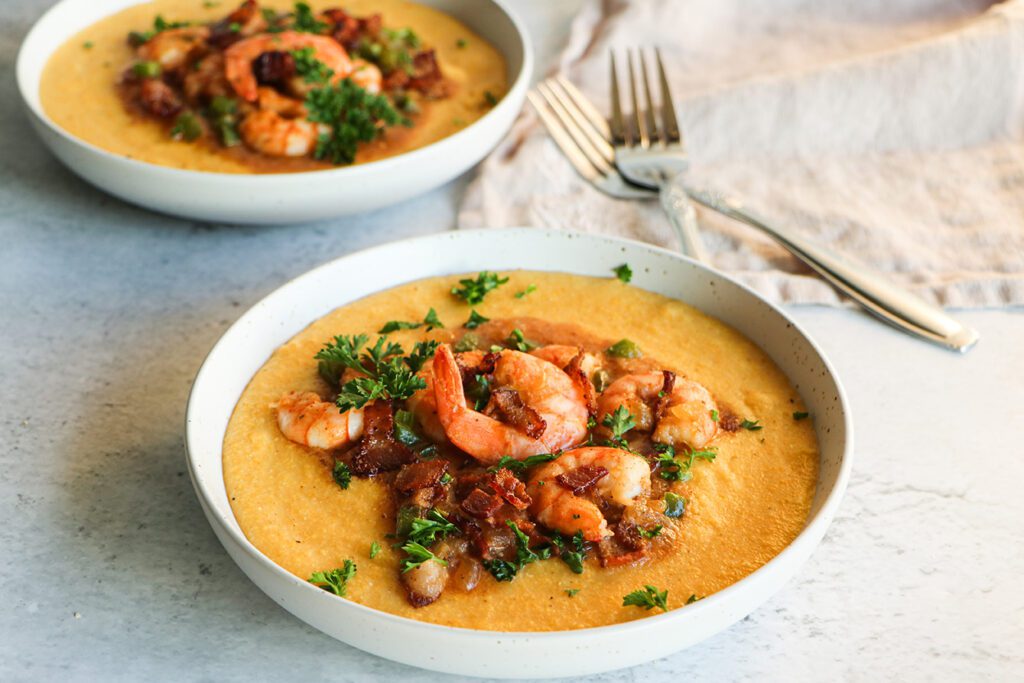
Know Your Grits
How to Select the Right Type For You
Unless you are a southern chef, selecting the right type of grits for your dish may be confusing with so many options available. What is the difference between quick and instant grits, anyway? Before whipping up that perfect pot of grits, read on to better understand the differences between the options available and how make the best selection for you.
Instant Grits
Instant grits are the fastest cooking grits you can make. They are a fine-grind and pre-cooked and dehydrated before packaging to reduce their cooking time. Instant grits cook in under two minutes by microwaving them with hot water or by simply mixing them into boiling water.
Although they are arguably the most convenient option, instant grits are typically considered to be less flavorful than other grits and lack the texture of more traditional varieties. For those in a hurry or short on time, instant may be the choice for you. For those more focused on quality and flavor, other varieties of grits may be a better option.
Quick Grits
Quick grits are a finer grind than more traditional selections, but unlike instant grits they are not precooked and dehydrated. Their finer grind also allows them to cook quickly, hence the name, typically in about 5-7 minutes. Like regular grits, they are processed and have a long shelf life.
Quick grits are a good option for those who want the convenience of instant grits and a flavor more similar to traditional grits.

Regular or Old Fashioned Grits
Regular grits are medium-ground grits that cook in approximately ten minutes. This variety is often labeled as simply “grits” or with accompanying terms such as “old-fashioned,” “southern-style” and ”traditional” on their store packaging.
Like quick and instant grits, they are processed to have a long shelf life, however, regular grits have more traditional texture and flavor due to their larger grind. Regular grits are also typically a cheaper option than other types such as stone ground that tend to be more expensive. This choice of grits is for those who have a little extra time to cook and are looking for more flavor and better quality.
Hominy Grits
Hominy grits are a form of course-ground grits. This option has a naturally creamy, soft texture due to a process called nixtamalization. Before the corn is ground, the kernels are treated with lye, or sodium hydroxide, to make a product called hominy. Native Americans were the first to use this process. They would soak their corn overnight in a mixture of lime or ashes. Both the modern lye method and the lime or ash are alkaline solutions, which break down the hull of the corn and softens the kernels. After soaking, the hominy is rinsed to remove the hulls, dried, and coarsely ground to make grits.
Nixamalization not only makes grits softer and creamier, but it also makes the corn more nutritious. Niacin, or vitamin B3, is released during the process and makes the corn easier to digest. Niacin can reduce cholesterol and lower the risk of heart attacks.
These grits are a good selection for those looking for a healthier alternative and are willing to spend a bit more time cooking.
Stone-Ground
Stone-ground grits are coarsely ground grits made from whole dried corn kernels, including the germ. They are ground using the traditional method with a grist mill, which is why these grits are considered “artisanal.” Stone-ground grits also have a longer cooking time – taking anywhere from 20-60 minutes.
Stone-ground grits have a more pleasing texture and rich, creamy flavor. Much like whole grain bread, because the germ is ground with the endosperm, these grits are healthier than other varieties. They also tend to be less processed and more perishable than other types.
Stone-ground are a more flavorful choice for those who want the real deal and are willing to spend a bit more time in the cooking process. They are better suited for holidays or barbecues than your average weekday breakfast.

Professor Torbert’s Orange Corn Grits
Still unsure of which grits are best for you? Professor Torbert’s Orange Corn polenta-grind grits are an option that has something for everyone! Ready in 15 minutes or less, these medium-ground grits deliver slow-simmered rich flavor in no time. Velvety smooth with a nutty, buttery finish, they work equally well for Southern classics like shrimp & grits or traditional Italian polenta recipes.
Not only do they taste good, but they’re good for you! Their vibrant orange color comes from increased levels of carotenoids. Carotenoids are shown to enhance your immune system and eye health. Feel good about what you eat by choosing Professor Torbert’s!
Ready to make your first pot of grits? Grab a bag today on our website and check out some of our favorite ways to use Professor Torbert’s Grits in our Recipe Library:
